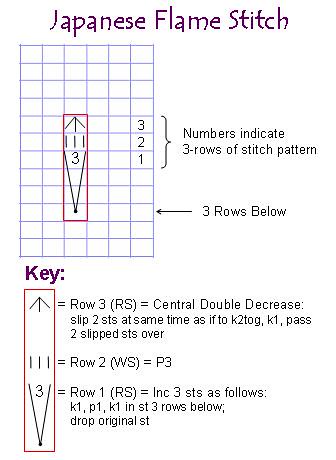I recently completed my Japanese Pullover, and was very flattered by the reception it got on the blog. Here is a photo as a reminder of what it looks like:

I don’t know what the Japanese name is for the stitch I used, so I called it a Japanese flame stitch. Many of you asked how the stitch is made, and so with Susan’s chart expertise and help, I’m finally able to explain it to you. It’s generally charted in Japanese patterns as shown below. Typically, as the chart shows, it is done by “dipping down” three rows and temporarily increasing one stitch to three. It can, however, be worked over more rows and I’ve seen some patterns where the stitch count is temporarily upped to five.
Here are some photographs to better illustrate what is being done. First, this stitch is started on the right side of the work and is done on a background of reverse stockinette. Look at the number “3” in the chart — that is the first row in which you do something different. When you get to the row that Susan labeled as #1, you work your way to the correct stitch, move your yarn to the back (b/c you are no longer purling), and increase by knitting, purling, and then knitting into the stitch three rows below). The first needle insertion looks like this:

Knit one stitch. It will look like this:

Move your yarn to the front and then re-insert the needle “through” the bump you went under the first time. It might be a little awkward but it can be done.

Purl.

Then move the yarn to the back and knit as you did with the first stitch.
Now, the next step is really important but it’s easy to forget: DROP THE NEXT STITCH FROM YOUR NEEDLE.
The “next stitch” is really the same stitch you’ve just knit into three times. If you don’t drop it, you’ll accidentally increase the number of stitches in whatever you are knitting. The dropped stitch will eventually run back the three rows on its own, but it can’t go further because you’ve knit into it three times. Remember, so you don’t hate yourself several rows later when your chart is screwed up, DROP THAT NEXT STITCH. Alrighty, then.
On the following wrong side row, purl the three stitches you just made. (Note: the other stitches will be knit because you are working reverse stockinette.) Then purl your way to the three new stitches. Your knitting should look like this:

At this point, you work a central double decrease as described in the chart above.

Then continue with reverse stockinette.

That’s all there is to it!
(Ack! Ignore my hands in these photos — I can’t take very good care of them right now although they were happy for a few minutes of being out of the splints.)































